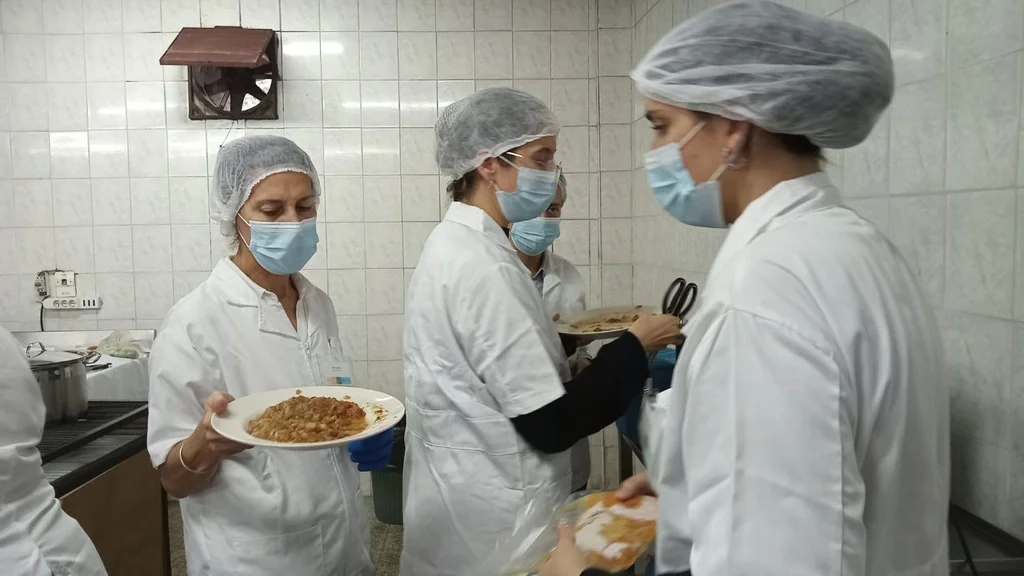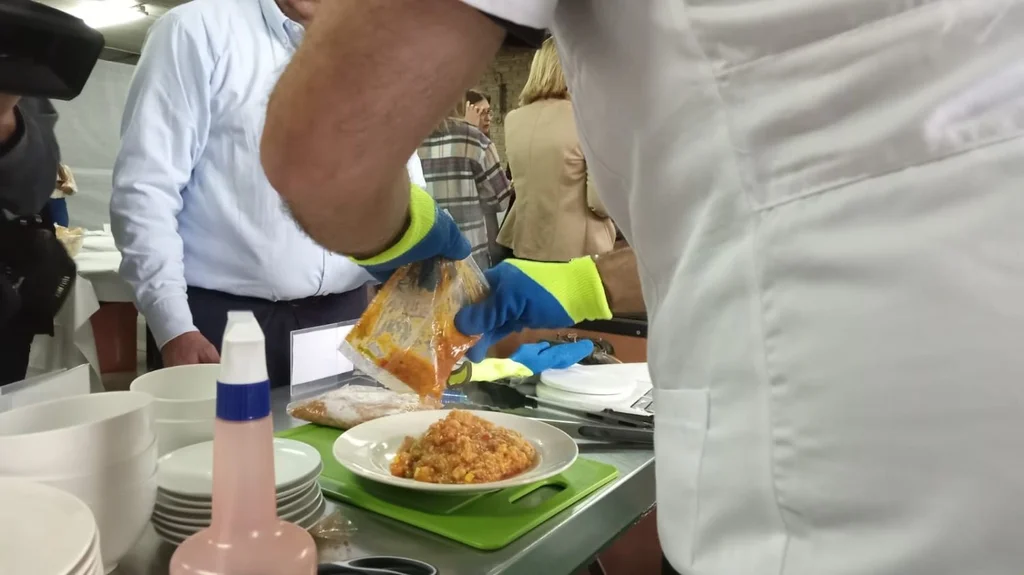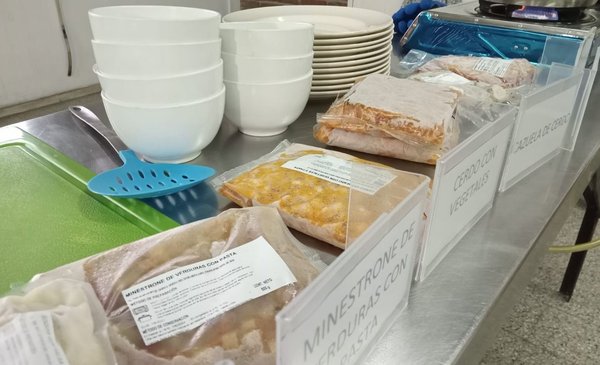Flavia arrived this Thursday at look for three viandas so that she and her two children could have lunch. With her four-year-old son in the car and a cloth bag, she approached the refrigerated truck where the moving point of Territorial Food Program (PAT) of the Ministry of Social Development (Mides).
He signed up for the PAT in April and withdrew food for the first time on June 8. She took three food items: one for her four-year-old son, another for her 17-year-old daughter, and another for herself. While Mides did not contact her to confirm that she could withdraw food from the PAT, ate in popular pots and picnic areas neighborhoods in Malvín Norte, where he lives.
“The same with this is nothing. I have to keep looking”, he opined when leaving the UTU of Malvín Norte with the three viandas. For Flavia, the daily food she will receive from Mides It is one more of all that you have to cover during the dayevery day, for her and her two children because the PAT delivers a daily meal per family member the seven days of the week.
Maria Eugenia Scognamiglio
PAT mobile point
In almost four years unemployed, Flavia knows where to go to get food and what days each thing is served. The food that she gives her from Mides she complements with the picnic area that works in the INVE complex, in Hipólito Hirigoyen and Iguá. On Mondays and Wednesdays he goes to another one that works in the Hospital Pasteur square where a boy nicknamed “Chipi” gives him food, who even “gives yogurt to the children.” She also goes to the one in the Miraculous Medal and San Agustín Church, attached to the Pasteur Hospital. Some days he goes to Beatriz’s neighborhood picnic area and the one that Karen does “sometimes”. On weekends it covers food in another near the Piñeyro del Campowhere on Saturdays they give them food and on Sundays “only milk”.
When the Mides outlined the PAT, it defined criteria to grant the food. identified and included people in a situation of “extreme poverty or indigence” –who have income below the value of the Basic Food Basket– already people below the poverty line. In this last group, priority was given to households composed of women and children, adults living alone and disabled people.

Maria Eugenia Scognamiglio
Frozen food provided by Mides
Flavia’s case is one of the latter. Two of her children live in her home: Agustín and Florencia. And the The only income she receives are the two family allowances for her minor children. “I haven’t had a job for almost four years because he has problems -he points to his son-, I have him undergoing treatment and he is still on the waiting list. They don’t know if he has some degree of autism, but he doesn’t talk to me, he wears diapersand we keep going around here and there,” he said. “That’s why I have to do this. I have no choice”he said of the ways in which he “gambles” to feed his family.
the ones left out
When the PAT emerged, the Mides had decided to remove support from the popular pots. Between comings and goings about the number of people who went to a neighborhood pot to eat, finally the Minister Martín Lema announced that no more supplies would be delivered to Uruguay Adelantethe intermediary organization.
But, the pots continued to exist. Some with the contribution of neighbors or cooperatives and others through social organizations and even with the support of the Municipality of Montevideo.
Fabiana Barros still maintains her soup kitchen in the Casabó neighborhood. The neighborhood referent –who is not part of any network of pots– sat down to observe a mobile point of the PAT and it seemed to her that it worked well and that the food seemed tasty. But, in her opinion, the system leaves people in need out. “If you earn $18,000 per month and have six children You manage to solve the food until the 20th. However, these people do not enter this system because they do not meet the requirements,” he said.
According to his vision, the PAT did not include people who, although they receive income and can feed themselvesThey don’t make it to the end of the month. And he says he sees him in his own pot: “At the beginning of the month, lonely, elderly, destitute people come. After the 18th or 20th, fathers, mothers, families, heads of households come and I have twice as many diners”counted and considered that “nobody goes out to look for a food container and lines up if they don’t need it.”
On the other hand, among those who enrolled in PATaccess to food has been a slow process. María Cristina went on Thursday with her sister. It had been registered, but the Mides had to cross data with the BPS to approve it and there had been no news.
Although María Cristina left with a meal of bondiola, potato and sweet potato that day, the next day he could no longer withdraw it because they informed him that they would call it when it was approved as a PAT user. “Tomorrow I will watch TV” she said, when asked about how she would feed herself because she said that she was 64 years old, did not work or receive retirement or pensions. The previous days “I have asked for rice, the neighbors have helped me,” she said.
The director of INDA, Ignacio Elgue explained that the process takes “10 or 15 days” since the person registers and the Mides approves it. So far, no one has been rejected.
Meanwhile, the Coordinadora de Ollas Populares assures that its work has not diminished and that there are more than 200 initiatives that continue to work. Now, without the support of Mides, they search with the ABC Plan of the Municipality of Montevideo and with other donations.
The data on which the Mides was based
Beyond the discussion about whether the PAT is enough or not, in the Mides they transmit that the program directly assists people in a situation of food insecurityan indicator that was measured in the Continuous Household Survey of 2022.
According to the survey, “26 out of every 1,000 households had been left without food due to lack of money or other resources” and “someone in the household had not eaten all day, at least once in the last 12 months.” In total, 2.6% of households experienced severe food insecurity and 15% moderate or severe.

Maria Eugenia Scognamiglio
Presentation of frozen food to legislators
The households most affected by food insecurity –and which determined the definition of who the PAT would reach– are those made up of boys and girls under six years of age and whose income is in the first income quintile. The Observer consulted the Mides how many people did the PAT reach so far but did not obtain the data at the close of this edition. Director of the National Food Institute (INDA), Ignacio Elgue, told Radio Universal a few days ago that food had been delivered to 4,500 people.
In any case, the Mides has capacity to deliver 1,200,000 meals because that is how the contract was signed with the three companies that provide the frozen food that is delivered in the mobile and fixed posts of the PAT. Therefore, the program will last as long as it takes to deliver that amount of food. “It depends on the demand, but we have the economic capacity to expand it by 100%,” Elgue said..
This Thursday, for example, some 2,000 food items in fixed and mobile stalls and from next week they will be delivered 3,000 per day, because more people were confirmed as PAT beneficiaries.






